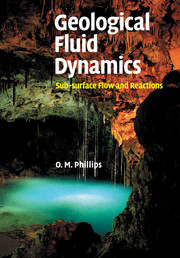4 - Flows with buoyancy variations
Published online by Cambridge University Press: 25 January 2011
Summary
The occurrence of thermally driven flows
A fundamental difference between constant density Darcy flows and those influenced by variations in buoyancy of the interstitial fluid is the absence of a uniqueness theorem in the latter situation. This is not just a matter of our being unable to prove such a theorem. In buoyancy-driven flows, different flow and temperature patterns can in fact occur in a given geometry and the same boundary conditions, and this raises new questions about the stability of flow patterns and the conditions under which one pattern can evolve into another. Internal circulating flows are prohibited in Darcy flows with uniform buoyancy, even though the permeability may vary arbitrarily, but now, flow rotation becomes of great interest, both in theory and in field observation.
Variations in buoyancy of interstitial fluids may be the result of variations in salinity, but are more commonly associated with temperature. The temperature variations that both drive subterranean flows, and are also modified by them, are generally the result of the geothermal heat flux from the earth's interior. The average upward heat flux in continental areas is about 2 × 10−6 cal cm−2 s−1, a very small fraction of the mean incident solar energy flux. The mean temperature gradient in the earth's upper crust is some 2–3 °C per 100 m, but this gradient and the local heat flux are concentrated and augmented in volcanic and hydrothermal areas by convective heat transfer associated with bodily fluid movements.
- Type
- Chapter
- Information
- Geological Fluid DynamicsSub-surface Flow and Reactions, pp. 125 - 193Publisher: Cambridge University PressPrint publication year: 2009



